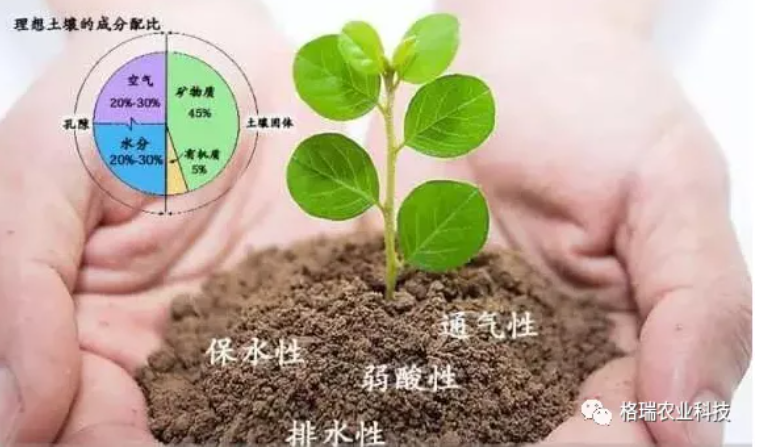|
|
Whether the soil organic matter content is high is directly related to it!1. What is soil organic matter? Soil organic matter refers to carbon-containing organic matter present in soil. It includes the residues of various animals and plants, microorganisms and various organic matters that can be decomposed and synthesized. Soil organic matter is an important component of the soil solid phase. Although the content of soil organic matter only accounts for a small part of the total soil, it is extremely important for soil formation, soil fertility, environmental protection and sustainable development of agriculture and forestry. effect.
2. Organic matter content determines soil type The content of soil organic matter varies greatly in different soils. The high content can reach 20% or more than 30% (such as peat soil, northeast black soil, etc.), and the low content is less than 1% or 0.5% (such as desert soil and aeolian sandy soil). Wait). In soil science, soils containing more than 20% organic matter in the ploughing layer are generally called organic soils, and soils containing less than 20% organic matter are called mineral soils. Under normal circumstances, the soil organic matter content of the tillage layer is usually above 5%. 3. Existence of soil organic matter Organic matter entering the soil generally exists in three types of states. (1) Fresh organic matter: Refers to those animal and plant residues that have entered the soil and have not been decomposed by microorganisms. They still retain their original shape and other characteristics. (2) Decomposed organic matter: After the decomposition of microorganisms, the animal and plant residues entering the soil have lost their original morphology and other characteristics. The organic matter is partially decomposed and tangled with each other, giving it a brownish color. Including organic matter decomposition products and newly synthesized simple organic compounds. (3) Humus: It refers to a brown or dark brown macromolecular colloidal substance that is decomposed and resynthesized by microorganisms. It is closely combined with soil minerals and soil particles and is the main morphological type of soil organic matter, accounting for 85-90% of the total soil organic matter. 4. Soil organic matter needs microbial transformation The microbial transformation process of soil organic matter is the most important and active process of soil organic matter transformation.
(1) Transformation of nitrogen-containing organic matter by microorganisms ①Hydrolysis process Proteins are decomposed into simple amino acid nitrogen-containing compounds under the action of proteolytic enzymes secreted by microorganisms. ②Ammonification process The amino acid produced by protein hydrolysis is in the process of producing ammonia under the action of various microorganisms and their secreted enzymes. ③ Nitrification process In the case of good ventilation, the ammonia produced by ammoniation can be further oxidized to nitric acid through the intermediate stage of nitrous acid under the action of soil microorganisms. This oxidation of ammonia to nitric acid by microorganisms is called nitrification. The conversion of nitrate to nitrite is called nitrosation. ④Denitrification process Nitrate nitrogen is reduced to gaseous nitrogen (N2O and N2) under the condition of poor soil aeration. This biochemical reaction is called denitrification. (2) Transformation of Phosphorus-Containing Organic Matter by Microorganisms The organic phosphorus in the soil can be absorbed and utilized by plants only after being decomposed into inorganic soluble substances by microorganisms. 20%-50% of the soil surface layer is in the state of organic phosphorus, mainly including nucleoprotein, nucleic acid, phospholipid, nuclide, etc. Under the action of various saprophytic microorganisms, the final product of decomposition of these substances is orthophosphoric acid and its salts class, which can be absorbed and utilized by plants. (3) Transformation of Sulfur-Containing Organic Matter by Microorganisms
Sulfur-containing organic compounds in the soil, such as sulfur-containing proteins, cystine, etc., are decomposed by microorganisms to produce hydrogen sulfide. Under the condition of good ventilation, hydrogen sulfide is oxidized into sulfuric acid under the action of sulfur bacteria, and forms sulfate with base ions in the soil, which not only eliminates the toxic effect of hydrogen sulfide, but also becomes a sulfur nutrient that plants can easily absorb. It is estimated that after a year of degradation of the organic residues entering the soil, more than 2/3 of the organic matter is released and lost in the form of carbon dioxide, and less than 1/3 of the organic matter remaining in the soil, of which the soil microbial biomass accounts for 3%-8 %, non-humic substances such as polysaccharides, polysaccharides, and organic acids account for 3%-8%, and humic substances account for 10%-30%. The annual residual amount of plant roots in soil is slightly higher than other aerial parts. |






